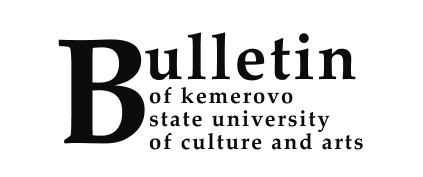THE CONCEPT OF A “LIVING MUSEUM” OF PRIEST PAUL FLORENSKY AND FORMS OF EXISTENCE OF MODERN CHURCH MUSEUMS
UDC index:
008
DOI:
Article ID in the RSCI:
Article file: Download
Information about authors: Alekseeva Larisa Sergeevna, Sr. Instructor, Department of Museum Sciences, Kemerovo State University of Culture (Kemerovo, Russian Federation). E-mail: alekslora@mail.ru Olenich Lyudmila Vladimirovna, Associate Professor of Department of Culturology, Member of the Union of Artists of the Russian Federation, Kemerovo State University of Culture (Kemerovo, Russian Federation). E-mail: olenich_l@mail.ru
Annotation: In the first quarter of the 20th century, the idea of priest Pavel Florensky about the “living museum” was being formed. Combining the experience of religious faith with symbolism, aimed at the search for a holistic vision of the world on the basis of sacred ideas, there appears the idea of preserving the heritage of the Russian Orthodox Church and the traditions and customs existing therein, in the synthetic activity of the museum and the Church. On the example of the Trinity Lavra of St. Sergius, priest Pavel Florensky under the church “living museum” presupposes the preservation (conservation and museumification) of the integral museum organism as a complex that combines the sacred space of the temple and the activities of the monastery’s inhabitants, material and intangible heritage, for the idea of the Universe and Revelation. The author of the concept supposed to turn the Trinity Lavra of St. Sergius into a kind of laboratory where the church ritual life, educational and scientific institutions were combined, which helps to preserve and study the “spiritual making” of the monastic community. Given the complex historical conditions (of the 1920s), in which the concept was developed, its application could not be implemented. With the revival of the Russian Orthodox Church at the end of the 20th century, there was a quantitative growth of church museums, which were primarily designed to carry out social and communicative activities (through the accumulation, storage, broadcasting) of monuments of religious origin. Therefore, before the museologists arose the question of finding the methods for actualizing the church heritage while preserving its sacral content. The authors of this study consider a number of methods existing in museum practice of actualizing monuments of religious origin to meet certain elements of the Florensky “living museum” concept but also expand the possibilities for its application.
Keywords: modern, Pavel Florensky, Trinity Lavra of St. Sergius, temple action, “living museum,” museumification, church museum.
DOI:
Article ID in the RSCI:
Article file: Download
Information about authors: Alekseeva Larisa Sergeevna, Sr. Instructor, Department of Museum Sciences, Kemerovo State University of Culture (Kemerovo, Russian Federation). E-mail: alekslora@mail.ru Olenich Lyudmila Vladimirovna, Associate Professor of Department of Culturology, Member of the Union of Artists of the Russian Federation, Kemerovo State University of Culture (Kemerovo, Russian Federation). E-mail: olenich_l@mail.ru
Annotation: In the first quarter of the 20th century, the idea of priest Pavel Florensky about the “living museum” was being formed. Combining the experience of religious faith with symbolism, aimed at the search for a holistic vision of the world on the basis of sacred ideas, there appears the idea of preserving the heritage of the Russian Orthodox Church and the traditions and customs existing therein, in the synthetic activity of the museum and the Church. On the example of the Trinity Lavra of St. Sergius, priest Pavel Florensky under the church “living museum” presupposes the preservation (conservation and museumification) of the integral museum organism as a complex that combines the sacred space of the temple and the activities of the monastery’s inhabitants, material and intangible heritage, for the idea of the Universe and Revelation. The author of the concept supposed to turn the Trinity Lavra of St. Sergius into a kind of laboratory where the church ritual life, educational and scientific institutions were combined, which helps to preserve and study the “spiritual making” of the monastic community. Given the complex historical conditions (of the 1920s), in which the concept was developed, its application could not be implemented. With the revival of the Russian Orthodox Church at the end of the 20th century, there was a quantitative growth of church museums, which were primarily designed to carry out social and communicative activities (through the accumulation, storage, broadcasting) of monuments of religious origin. Therefore, before the museologists arose the question of finding the methods for actualizing the church heritage while preserving its sacral content. The authors of this study consider a number of methods existing in museum practice of actualizing monuments of religious origin to meet certain elements of the Florensky “living museum” concept but also expand the possibilities for its application.
Keywords: modern, Pavel Florensky, Trinity Lavra of St. Sergius, temple action, “living museum,” museumification, church museum.
